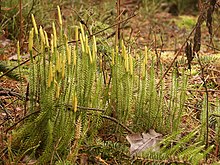Lycopodium annotinum
| Lycopodium annotinum | |
|---|---|
 | |
| Scientific classification | |
| Kingdom: | Plantae |
| Clade: | Tracheophytes |
| Clade: | Lycophytes |
| Class: | Lycopodiopsida |
| Order: | Lycopodiales |
| Family: | Lycopodiaceae |
| Genus: | Spinulum |
| Species: | S. annotinum |
| Binomial name | |
| Spinulum annotinum (L.) A.Haines | |
| Synonyms | |
| |
Spinulum annotinum, synonym Lycopodium annotinum, known as interrupted club-moss,[1] or stiff clubmoss,[2] is a species of clubmoss native to forests of the colder parts of North America (Greenland, St. Pierre & Miquelon, all 10 provinces and all 3 territories of Canada, Alaska, and mountains of the contiguous United States),[3] as well as Asia (China, Russia, Japan, Korea, Nepal, Assam),[4] and most of Europe.[5] It is an evergreen perennial pteridophyte.[6] The genus Spinulum is accepted in the Pteridophyte Phylogeny Group classification of 2016 (PPG I),[7] but not in other classifications, which submerge the genus in Lycopodium.[8]
Description
[edit]Spinulum annotinum is a common and widespread club-moss spreading by means of horizontal stems running along the surface of the ground. It is usually unbranched or sparingly branched, each branch containing a cone at the top. Leaves have minute teeth on their edges.[9][10][11] The branches are 5-25 cm long, upright and somewhat branchless themselves. The sporangium are located at the top of the branches in individually located spore cones.[6]
Uses
[edit]In Finnish traditional medicine Spinulum annotinum has been used as a remedy for rickets. The plant's spore dust has also been used as medicine for rashes and inflammation. The spore dust or lycopodium powder has also been used as 'fly gunpowder' (kärpäsruuti in Finnish) due to the oily and easily flammable nature of the spores.[6]
The plant has been used as decoration in binding crafts in Finland.[6]

References
[edit]- ^ BSBI List 2007 (xls). Botanical Society of Britain and Ireland. Archived from the original (xls) on 2015-06-26. Retrieved 2014-10-17.
- ^ USDA, NRCS (n.d.). "Lycopodium annotinum". The PLANTS Database (plants.usda.gov). Greensboro, North Carolina: National Plant Data Team. Retrieved 24 June 2015.
- ^ "Spinulum annotinum". State-level distribution map from the North American Plant Atlas (NAPA). Biota of North America Program (BONAP). 2014.
- ^ Zhang, Li-Bing; Iwatsuki, Kunio. "Lycopodium annotinum". Flora of China. Vol. 2 – via eFloras.org, Missouri Botanical Garden, St. Louis, MO & Harvard University Herbaria, Cambridge, MA.
- ^ Altervista Flora Italiana, Licopodio gineprino, Lycopodium annotinum L. includes photos and European distribution map
- ^ a b c d Piirainen, Mikko; Piirainen, Pirkko; Vainio, Hannele (1999). Kotimaan luonnonkasvit [Native wild plants] (in Finnish). Porvoo, Finland: WSOY. p. 15. ISBN 951-0-23001-4.
- ^ PPG I (2016). "A community-derived classification for extant lycophytes and ferns". Journal of Systematics and Evolution. 54 (6): 563–603. doi:10.1111/jse.12229. S2CID 39980610.
- ^ Christenhusz, Maarten J.M. & Chase, Mark W. (2014). "Trends and concepts in fern classification". Annals of Botany. 113 (9): 571–594. doi:10.1093/aob/mct299. PMC 3936591. PMID 24532607.
- ^ Wagner Jr., Warren H.; Beitel, Joseph M. (1993). "Lycopodium annotinum". In Flora of North America Editorial Committee (ed.). Flora of North America North of Mexico (FNA). Vol. 2. New York and Oxford: Oxford University Press – via eFloras.org, Missouri Botanical Garden, St. Louis, MO & Harvard University Herbaria, Cambridge, MA.
- ^ Aiken, S.G.; Dallwitz, M.J.; Consaul, L.L.; McJannet, C.L.; Boles, R.L.; Argus, G.W.; Gillett, J.M.; Scott, P.J.; Elven, R.; LeBlanc, M.C.; Gillespie, L.J.; Brysting, A.K.; Solstad, H.; Harris, J.G. (2007). "Lycopodium annotinum subsp. alpestre". Flora of the Canadian Arctic Archipelago: Descriptions, Illustrations, Identification, and Information Retrieval. Ottawa: NRC Research Press, National Research Council of Canada. Archived from the original on 9 March 2023. Retrieved 16 April 2024.
- ^ "Lycopodium annotinum L., Lycopode à rameaux annuels". Tela Botanica (in French).
External links
[edit]- Photo of herbarium specimen at Missouri Botanical Garden, collected on Mt. Adams in New Hampshire in 1889, neotype of Lycopodium annotinum
- Go Botany, New England Wildflower Society, Spinulum annotinum (L.) A. Haines bristly clubmoss, common interrupted-clubmoss] photos plus New England distribution map
- Michigan Flora, Spinulum annotinum (L.) A. Haines photos plus Michigan distribution map
- Digital Atlas of the Virginia Flora, Spinulum annotinum (L.) A. Haines photos plus Virginia distribution map
- Boreal Forest, Lycopodium annotinum Stiff Clubmoss description, photos, ecological information
- West Highland (Scotland) Flora, Interrupted Clubmoss, Lycopodium annotinum photos from near Skye in Scotland


 French
French Deutsch
Deutsch